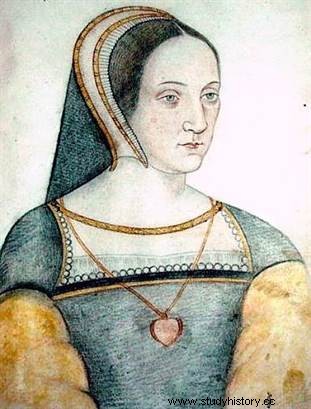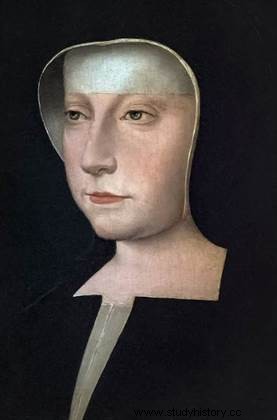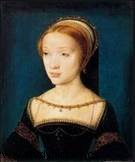 Mother, sister, wives, mistresses, many are the women who surrounded by the same adoration Francis I , a magnificent king in his court like a sultan in his Harem, devoting their whole life to him. He accepted their gift as his due, like a child spoiled by fortune. Louise de Savoie, Marguerite de Navarre, Anne de Pisseleu, Claude de France and especially Françoise de Châteaubriant , all exceptional women from a flamboyant and eventful reign.
Mother, sister, wives, mistresses, many are the women who surrounded by the same adoration Francis I , a magnificent king in his court like a sultan in his Harem, devoting their whole life to him. He accepted their gift as his due, like a child spoiled by fortune. Louise de Savoie, Marguerite de Navarre, Anne de Pisseleu, Claude de France and especially Françoise de Châteaubriant , all exceptional women from a flamboyant and eventful reign.
Francis I and the Breton question
Apart from his tall stature, Francis I was a refined, intelligent and superficial man, art lover, excellent horseman, appreciating luxury and especially beautiful women. Around him constantly flutter a group of young and charming people whom he affectionately called his "little Band". This does not prevent him from taking care of state affairs and fighting, winning laurels in Marignan . Despite his marriage to the daughter of Anne de Bretagne, one question worried him a great deal:this convention, which made Brittany a state free to separate from France at any time, risked causing him to lose many rich baronies.
 Most of these Breton fiefdoms happened to belong to Lord Jean de Laval, whom François hastened to invite at court, as well as his charming wife, cousin of Anne of Brittany. This is Françoise de Foix born in 1475 and engaged at the age of 11 to the wealthy Sieur de Laval-Chateaubriand. From an early age, the exquisite young girl showed promise with her assertive character, her smooth complexion, her harmonious proportions and the beauty of her black hair. Jean will therefore marry her in 1509 and will live happily in his county of Brittany with his beautiful. Until François I hears about Françoise.
Most of these Breton fiefdoms happened to belong to Lord Jean de Laval, whom François hastened to invite at court, as well as his charming wife, cousin of Anne of Brittany. This is Françoise de Foix born in 1475 and engaged at the age of 11 to the wealthy Sieur de Laval-Chateaubriand. From an early age, the exquisite young girl showed promise with her assertive character, her smooth complexion, her harmonious proportions and the beauty of her black hair. Jean will therefore marry her in 1509 and will live happily in his county of Brittany with his beautiful. Until François I hears about Françoise.
The young king is impatient to meet this pretty lady whose fame has reached the court, but Jean de Laval who knows the king's penchant for women, will go alone to his invitation, citing Françoise's fierce nature. This only aroused the curiosity of the king, who repeatedly insisted and finally demanded his arrival. Jean de Laval then attempting a final strategy, known as the ring , wrote a letter before the king asking his wife to go to court, enclosing a ring which told the recipient to disregard the mail when it contained said ring. This desperate attempt by the husband will be thwarted by a valet of the king who will remove the ring from the mail, and the inevitable happens. Françoise goes to the court, and is immediately presented to the king who immediately falls under the spell.
He will pay her a court full of courtesy to which the beauty will not be insensitive:"Entering the king's bed has many advantages is she thought to herself. Quickly, because François liked business smoothly, she becomes his mistress, making a fierce enemy of L ouise of Savoy , influential mother of the king. To soften the jealousy of the deceived husband, Francis will offer him the command of a company of orderlies, and will appoint the brother of his beloved governor of Milan.
Françoise de Châteaubriant, royal favourite
In 1520, in anticipation of a confrontation he considered inevitable with the very powerful Charles V, François 1er tried to ally himself with Henry VIII of England . For this purpose, he will choose a neutral place where French and English can negotiate an agreement. Influenced by the beautiful Françoise, he erected sumptuous tents decorated with tapestries and precious furniture, where magnificent parties were held to dazzle Henry VIII.
This is the camp of the cloth of gold, an operation so costly that it will empty the coffers of the State and will have the consequence of producing the opposite effect to that expected:Henri, humiliated and furious, will return to England and will ally with Charles V.
 Louise of Savoy, very angry, will of course blame this failure on the king's mistress and wage war on her without mercy, accusing her of being the mistress of Bonnivet, admiral of the king, which was true. But the king, blinded, will not take it into account. During a drunken party, a guest threw a burning brand at François' head, putting his life in danger. He will eventually recover and this accident will inspire a fashion which was to characterize the man of the XVI
th
century:the king's curls were cut, he had to let his beard grow to hide the scars of his burns. All the men of the kingdom and of Europe will adopt this new style.
Louise of Savoy, very angry, will of course blame this failure on the king's mistress and wage war on her without mercy, accusing her of being the mistress of Bonnivet, admiral of the king, which was true. But the king, blinded, will not take it into account. During a drunken party, a guest threw a burning brand at François' head, putting his life in danger. He will eventually recover and this accident will inspire a fashion which was to characterize the man of the XVI
th
century:the king's curls were cut, he had to let his beard grow to hide the scars of his burns. All the men of the kingdom and of Europe will adopt this new style.
In 1526 Francis I, who set out to conquer Italy, was defeated at Pavia and taken prisoner by Charles V, to the great despair of Françoise. Louise of Savoy, her great enemy, will be appointed regent, leaving her no choice but to pack up and go to Brittany, where her husband no doubt gave her a warm welcome. An assiduous and very poetic correspondence will be established between the two lovers, which will soften the long months of captivity of the king in Spain. Queen Claude having died discreetly in 1524, François Ier will agree for political purposes to marry Eléonore, sister of Charles V, who immediately falls in love with this so seductive king.
Time for rivals
A large ransom had been demanded for his release, and the king promises to comply. He was released in 1526 and returned to France, acclaimed by his people. In Brittany, where the news reached, Françoise is waiting for a sign from her beloved, who will not come, and for good reason. She will go to court to find a terrible rival in the person of Anne de Pisseleu , Duchess of Etampes, a beautiful 18-year-old blonde girl, with whom she will have to fight to keep her title of royal favourite. A fierce hatred will oppose the two women, to the delight of the courtiers who will revel in this rivalry. The king, who adored his new mistress, but still loved Françoise, found himself very annoyed by this situation, using his diplomacy to appease the two favorites, in vain.
Annoyed by the weakness of the king, wounded in his pride, Françoise leaves the court and returns to Brittany. Anne, the victorious favourite, not intending to stop there, will demand from the king the restitution of the jewels offered to Françoise on which beautiful mottoes were engraved. Thwarting the pettiness of her rival, the fallen favorite had the jewels melted down and brought back to the king in the form of gold bars. The latter, somewhat resentful and amused by this gesture, had the ingots sent back and the affair turned against the jealous favourite.
 The king, having had important business to settle in Brittany in 1532, will settle in Châteaubriant for six weeks to the great happiness of Françoise, perhaps less than that of her husband. In his honor will be given many parties, tournaments, hunts and banquets. But the king, his business done, will return to the court where Anne de Pisseleu awaits him with the impatience that we can imagine. Françoise was never to see François I again. However, several years of correspondence followed. between these two beings who decidedly liked each other a lot.
The king, having had important business to settle in Brittany in 1532, will settle in Châteaubriant for six weeks to the great happiness of Françoise, perhaps less than that of her husband. In his honor will be given many parties, tournaments, hunts and banquets. But the king, his business done, will return to the court where Anne de Pisseleu awaits him with the impatience that we can imagine. Françoise was never to see François I again. However, several years of correspondence followed. between these two beings who decidedly liked each other a lot.
Jean de Laval, whom the king had showered with honor, got on very well with him on political issues, but what about relations of this flouted husband with his wife? In revenge, he would have abused this woman who had cheated on him. Are these bad rumours? The mystery remains on the brutal death of Françoise in 1537. It was rumored that her husband, mad with jealousy, would have murdered her. But has public opinion, eager for dark and tragic stories, peddled baseless facts? No doubt we will never know.
Bibliography
- The Women of Francis I by Christiane Gil. Pygmalion, 2005.
- Francis I:The King-Knight by Georges Bordonove. Pygmalion, 2006.
- Diary of the mother of Francis I:1459-1522 by Louise De Savoie. Paleo, 2006.
